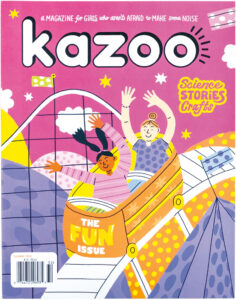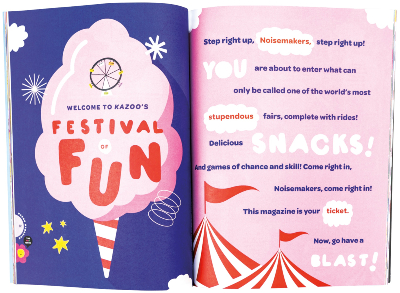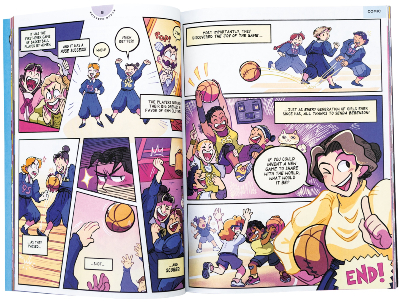The Little Magazine That Could
With a full-time staff of one, this ad-free indie children’s magazine has defied all odds, winning the National Magazine Award for General Excellence and expanding its reach to readers in 53 countries around the world. Founder and Editor-in-Chief Erin Bried shares not only how she did it, but how she plans to keep going and growing.
By Erin Bried
We called it the “Room of Doom.” Everybody knew deep staffing cuts were coming—we’d been warned of them that morning—and now every editor, designer, factchecker, and copyeditor was just lulling about the 22nd floor of 1 World Trade, waiting for our phones to ring. We knew that on the other end of the line would be Human Resources, calling us down, one after the other after the other, to a windowless room somewhere below to deliver the news: “We need to cut your position. Thank you for your service. Do you have any questions about your severance package?”
This was 2015, and I got my call. It was just weeks after I’d returned from maternity leave. I was an editor-at-large at SELF magazine, where I’d spent more than a decade writing cover stories. I’d gone kickboxing with Anne Hathaway, shared a six-course dinner with Cameron Diaz, meditated with Rosario Dawson, salsa danced with Christina Applegate, and interviewed Taylor Swift, Beyonce, and Angelina Jolie to name just a few. I used to half-joke, half-brag that you could name any woman in Hollywood, and I’ve probably interviewed her at least once.
Times had changed since I’d started at Condé Nast in 1997. Back then, it was strictly a print magazine publisher, but during my tenure, it, like many big publishing houses, slowly, then quickly, evolved into a multi-media entertainment company. It was no longer all about print, but also videos, TV shows, podcasts, and more. The pivot claimed many casualties, including storied publications like Gourmet, Mademoiselle, SELF, Lucky, Teen Vogue, even Glamour, all of which either went digital-only or went away altogether.
So, given my background and the seemingly dire state of our industry, you may find it curious that I decided, months after my unceremonious layoff, to launch my very own print magazine—an ad-free one at that. But after a fateful trip with my then 5-year-old daughter to our local bookstore, I felt it was something I had to do.
We were there to browse new books for her, and on the way out, we swept by the magazine racks, where all we saw for girls that day was magazines with princesses or pop stars on the cover. My daughter, whose interests at the time revolved mostly around space and how fast she could run, was bored. I was annoyed. Was this really the best we could offer our daughters? Soon, my annoyance turned into indignation. Somebody should really do something about this. This is part of the reason why girls’ confidence drops 30 percent between ages 8 and 14; and why by age 14, girls drop out of sports at twice the rate of boys; and why girls are less likely to go into STEM fields than boys. Eventually, it dawned on me: If I wanted to see change, I’d have to make it happen myself. After all, given my background as both a magazine editor and a mother of two daughters (my younger was only a few months old at the time), who was better equipped to do it than me?
With incredible encouragement and unending support from my wife, a literary agent who is also my behind-the-scenes collaborator on all things Kazoo, we sketched out an idea for a new kind of quarterly magazine for girls, ages 5 to 12, with a mission that is as radical as it is simple: to celebrate girls for being strong, smart, fierce, and true to themselves. It’d be like Sassy meets Highlights: cool and feminist, but for kids. We’d develop every story with top women in their fields—scientists, artists, athletes, engineers, chefs. We’d illustrate all of the experts, based on real childhood photos, so our young readers could more easily see themselves in future positions of power. (“What does a future Supreme Court Justice look like? Just like me!”) We’d avoid running photos of girls, so our readers could lose themselves in the stories, rather than compare themselves to others. We’d stay ad-free, because we didn’t want our readers to feel incomplete if they didn’t have a certain product. And we’d call it Kazoo, after the toy instrument, because not only is it fun, but also if you can breathe, you can make yourself heard, which is exactly what we want our readers to do. Kazoo’s tagline is “A Magazine for Girls Who Aren’t Afraid to Make Some Noise.”
There was just one catch: I had no money. I’m not independently wealthy, and I didn’t want investors, because I didn’t want to, inevitably, compromise my mission in order to meet someone else’s financial goals. So I took the idea directly to my would-be readers. Or rather, their grown-ups. In March 2016, I launched a Kickstarter campaign for Kazoo with a goal of raising $150,000. (I set the goal high because I needed to know that there was enough support to not just start, but sustain, a magazine like this.) I emailed everybody I’d ever known about it: former industry colleagues, press contacts, relatives, neighbors, even people I hadn’t seen or talked to since high school. (It was so terrifying, because it meant that if I failed, I was going to fail very publicly.) Two of my friends, who happen to be Emmy-nominated filmmakers, offered to make a launch video for the campaign, which soon went viral. Authors Neil Gaiman and Roxane Gay, both of whom I’d never met, helpfully tweeted about it. And then we had momentum. In 30 days, we raised more than $171,000 dollars from more than 3,000 backers, making Kazoo the highest funded journalism campaign in crowdfunding history at the time. It turns out I wasn’t the only one who wanted a smarter, cooler magazine for girls.
That was seven years—and 31 issues—ago. Since then, our subscriber base has grown to include, at last count, readers in 53 countries around the world. We’ve won the prestigious National Magazine Award for General Excellence and have been nominated for many other Ellie and ASME awards, including Best Single Topic Issue and Best Print Design. The New York Times even recently named Kazoo “one of the best gifts of the year.” And we’ve worked with an all-star roster of experts, including Jane Goodall, Ruth Bader Ginsburg, Misty Copeland, the U.S. Women’s National Team, Margaret Atwood, and Shonda Rhimes, among many, many others.
Kazoo is the story of the little magazine that could, which is not to say that keeping it going—and growing—has not been extremely challenging. Despite our awards and critical acclaim, I’m still the only full-time staffer. I write every story myself, except our fiction, and when I’m not writing, I’m planning the next issue, creating new renewal efforts, answering customer emails, visiting schools, and packing up issues to walk them to the post office. For as daunting as it can feel at times, it is also more rewarding than anything I’ve ever done. And along the way, I’ve learned many lessons about finding success in niche publishing. Here are a few that I’ve found most valuable:
Make Print Necessary
As we all well know, it is expensive to print and ship a paper magazine, even more so recently, as the costs of paper, postage, ink, and printing have skyrocketed. If you’re going to pay for print, you must have a darn good reason why. Kazoo has two. Being print-only by design is a selling point for us. No parent wants their young children to have more screen time. And second, we’ve designed Kazoo to be an interactive experience. Our pages are meant to be colored, written in, and, in some cases, cut out and cut up. You just can’t do that to an iPad.
Surprise and Delight Your Reader
We often plan wraparound covers with the goal of blowing our readers’ minds as they flip front to back. For example, for our Tiny Issue (#30), which explored the wonders of all things small, we featured a girl on the cover, illustrated by New York Times bestselling cartoonist Lucy Knisley, looking through a magnifying glass at a ladybug and saying “Whoa.” On the back cover, the perspective changes. We see the ladybug looking up at the girl, also saying “Whoa.” It’s funny, and unexpected, and it teaches our readers to see the world from a new angle—and that’s all before they even open the magazine.
Offer Something Unique
Kazoo is the only children’s magazine that runs original fiction—always an eight-page short story featuring a fierce girl protagonist—written by a top author. Our contributors include Newbery Medal winners, like Lois Lowry, Meg Medina, Erin Entrada Kelly, and Tae Keller; Pulitzer nominee Joyce Carol Oates; National Book Award finalists, like Lisa Yee and Angela Flournoy; and bestsellers like Emma Straub, Carmen Maria Machado, Kimberly Brubaker Bradley, and Meg Wolitzer. When you open Kazoo, you know you’ll find something special that you can’t find anywhere else. When we say there’s no other magazine like Kazoo, we truly mean it.
Refine Your Distribution
 Truthfully, I’m still working on this one. After a pandemic pause, we’ve resumed distribution at Barnes & Noble nationwide, and we’re now also on newsstands at most Whole Foods. But the percentage that the distributors who serve these large stores take is much higher than it was when we first launched; they now earn up to 30 percent more on each sale of a single issue than we do. I know Kazoo benefits their bottom line, but I’m constantly monitoring our sell-through to make sure it also benefits ours. I’ve found that when we work with smaller distributors, such as Small Changes in Seattle, the split is much more favorable and our sell-through rates are significantly higher. For indie bookstores, Kazoo isn’t just a space-filler on the bottom shelf of a messy newsstand, wedged somewhere between gun magazines and home design titles. It’s a magazine they’re eager to hand-sell, and they do. And we do our best to cultivate those relationships. If there’s an indie bookshop where we want to be, we’ll send them an issue, along with a letter and press packet, asking them stock us, and we refer them to Small Changes for the order. It benefits us all: the publisher, the distributor, and the bookseller.
Truthfully, I’m still working on this one. After a pandemic pause, we’ve resumed distribution at Barnes & Noble nationwide, and we’re now also on newsstands at most Whole Foods. But the percentage that the distributors who serve these large stores take is much higher than it was when we first launched; they now earn up to 30 percent more on each sale of a single issue than we do. I know Kazoo benefits their bottom line, but I’m constantly monitoring our sell-through to make sure it also benefits ours. I’ve found that when we work with smaller distributors, such as Small Changes in Seattle, the split is much more favorable and our sell-through rates are significantly higher. For indie bookstores, Kazoo isn’t just a space-filler on the bottom shelf of a messy newsstand, wedged somewhere between gun magazines and home design titles. It’s a magazine they’re eager to hand-sell, and they do. And we do our best to cultivate those relationships. If there’s an indie bookshop where we want to be, we’ll send them an issue, along with a letter and press packet, asking them stock us, and we refer them to Small Changes for the order. It benefits us all: the publisher, the distributor, and the bookseller.
Find Good Partners
Amazon is not one, no surprise there. The behemoth recently shut down subscription sales, almost overnight, which wasn’t great news for us. We do have beneficial relationships with lots of different subscription agencies, including EBSCO Information Services and WT Cox Information Services, who sell mainly to schools and libraries for a 10-percent commission. I’m always looking to expand our network, too, but only with supportive partners. I recently reached out to Magazines.com (owned by Dotdash Meredith) and Barnesandnoble.com to see if they’d sell Kazoo subscriptions. They’d love to, they said enthusiastically, before offering a 90/10 split—they’d keep 90 percent of every subscription sold, and we’d get 10 percent. I’m still flabbergasted by this. Those terms may work for publishers looking to boost their circulation at a loss in order to increase their ad prices; but as an ad-free, subscriber-funded indie, we obviously can’t give away 90 percent of our income. All of the agencies we choose to work with allow us to set our own remit terms. In addition to the two mentioned above, we also work with Rivistas Subscription Services; Discount Magazine Subscription Service, Inc.; and Prenax.
Start a Newsletter
 Social media algorithms were once our friend. Our Facebook and Instagram posts were seen widely, but then, suddenly and without warning, they weren’t. Now, if we want any of our followers to see our posts, we have to pay to boost them. It’s a fuzzy business, tracking whether views translate to subscriptions, so we opted for what feels like a surer approach. We started a newsletter, delivered via email, to about 15,000 past and present subscribers, or rather their parents, grandparents, aunts, and uncles. It includes Kazoo news and sales, but also photos, links to interesting news stories I’ve come across, books and recipes I love, and updates on what our contributors are up to. (None of it is sponsored content.) It’s just fun to write, and it helps start conversations and create a sense of community. And yes, it helps drive traffic to our website. Those numbers are easy to track. After all, word-of-mouth sales are an essential part of our business. In fact, if someone ever accidentally orders a duplicate copy of an issue, I always ask them to hand the extra to a kid, teacher, or librarian who may love it, joking that doing so makes them not only part of our marketing team, but our entire marketing team. It’s funny, because it’s true.
Social media algorithms were once our friend. Our Facebook and Instagram posts were seen widely, but then, suddenly and without warning, they weren’t. Now, if we want any of our followers to see our posts, we have to pay to boost them. It’s a fuzzy business, tracking whether views translate to subscriptions, so we opted for what feels like a surer approach. We started a newsletter, delivered via email, to about 15,000 past and present subscribers, or rather their parents, grandparents, aunts, and uncles. It includes Kazoo news and sales, but also photos, links to interesting news stories I’ve come across, books and recipes I love, and updates on what our contributors are up to. (None of it is sponsored content.) It’s just fun to write, and it helps start conversations and create a sense of community. And yes, it helps drive traffic to our website. Those numbers are easy to track. After all, word-of-mouth sales are an essential part of our business. In fact, if someone ever accidentally orders a duplicate copy of an issue, I always ask them to hand the extra to a kid, teacher, or librarian who may love it, joking that doing so makes them not only part of our marketing team, but our entire marketing team. It’s funny, because it’s true.
Stay True to Your Mission
Kazoo’s mission has always been crystal clear. We exist only to serve our young readers and to show them a world full of wonder and possibility. So, with every story we run and every piece of art we assign, we ask ourselves two questions: Does it serve our readers? And what makes this a Kazoo story, and not a story that might appear in any of our competitors’ magazines? If we can answer both questions without hesitation, then we know it’s a winner. And in this very difficult market, we know our unwavering faithfulness to our mission—to celebrate girls for being strong, smart, fierce, and true to themselves—is what’ll make Kazoo a winner, too.
Erin Bried is founder and editor of Kazoo and the mother of two daughters (aka Kazoo’s Tiny Editor and Teeny Editor). She’s also the editor of Kazoo’s graphic collection, “Noisemakers: 25 Women Who Raised Their Voices & Changed the World” (Knopf), and the author of three books, including “How to Sew a Button.” Connect via bried@pagesthemagazine.com.







